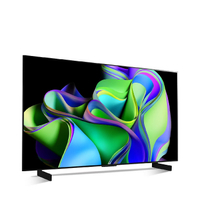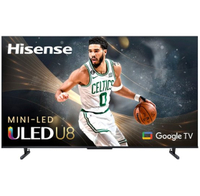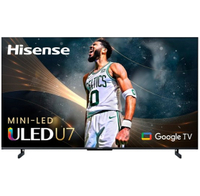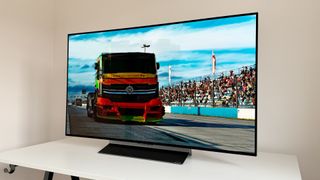
1. The list in brief
2. Best overall
3. Best 55-inch
4. Best 65-inch
5. How to choose
6. How we test
7. FAQ
While it might not buy you a huge, flagship TV, $1000 is a lot of money. Thankfully, it will also buy you a lot of TV – as you’ll see from this list of the best TVs under $1000.
With this budget, you will have to compromise slightly, either on performance or size, but the quality available at this price is nonetheless excellent. Our selections include OLED and Mini LED models, plus extra-affordable LCD sets, and you can expect serious smart TV capabilities and even top-notch gaming specs such as 4K/120Hz and VRR, too.
All of the recommendations you will see below are models that we have independently tested in our dedicated test rooms. Our team of expert reviewers has decades of combined experience in TV testing, and every model is compared directly with the best TVs available in its size and price category. You can read more about our testing process below, or simply scroll down to find the best TV under $1000 for you.
The Quick List
Here you'll see all of our recommendations for the best TVs under $1000, with a brief summary of why you should consider each model. If you want more detail on a model, simply click on it. Alternatively, simply scroll down to get all of the information on all of the TVs in our list – plus some extra models that you might want to consider.
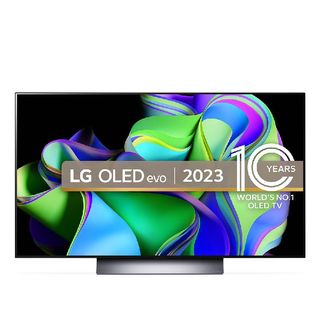
Best TV under $1000 overall
Thanks to heavy discounting, this 48-inch LG OLED is now within our budget and it's comfortably the best TV available for under $1000.
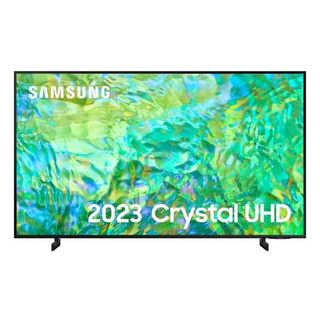
Best 55-inch TV under $1000
While not the highest-spec or most sophisticated-performing TV, this Samsung has good picture quality and a great smart platform and it costs under $500.

Best 65-inch TV under $1000
Now that it's been discounted, this 65-inch Mini LED from Hisense is an absolute bargain that offers near-flagship performance for under $1000.

I’m What Hi-Fi?’s TV & AV Editor, and I’ve been testing TVs (and many other AV and audio products) for over 17 years. I’m obsessed with TV picture quality, but I’m also obsessed with value for money. I believe a great movie experience should be available to all, so while I love flagship TVs, I love TVs that offer awesome bang for your buck even more. That’s exactly what you’ll find on this page – genuinely great TVs that cost less than $1000, all hand-picked by me and the rest of the What Hi-Fi? Reviews team.
Recent updates
10th May 2024: This page has had a complete redesign. We have added the Quick List, author info and new FAQs, and all of our recommendations have been replaced. We have also added 'Also' Consider' options for each entry.
The best TVs under $1000 in 2024
Why you can trust What Hi-Fi?
Below you will find full write-ups for all the best TVs under $1000. We've tested each model extensively (plus a huge number of alternatives that didn't make the grade), so you can be sure that our recommendations are properly researched and can be trusted.
Best TV under $1000 overall
When it first launched, the 48-inch LG C3 was a long way out of our $1000 budget. Now, almost a year since launch, it’s been discounted enough that it just sneaks in. And what a TV it is. While not a huge improvement on its C2 predecessor, the C3 is still an exceptional blend of performance, features and price.
The 48-inch C3 features the same super-compact pedestal stand of its larger siblings, rather than the feet of the 42-inch model (see below). This makes it easier to find space for but a little awkward if you’re going to add a soundbar. Perhaps unsurprisingly, the plastic enclosure for the set’s hardware and speakers covers more of the set’s rear than is the case with the larger C3 models, but the set is still slim (4.7cm) and very smart-looking indeed by general TV standards.
It’s very hard to find fault with the LG C3 in terms of features. Gamers will be delighted that all four of its HDMIs are 48Gbps HDMI 2.1 sockets with support for 4K/120Hz, VRR and ALLM, and the set supports Dolby Vision gaming (right up to 4K/120Hz) and has a brilliant HGiG setting that makes it easy to get the best HDR picture out of most modern games. The operating system is excellent, too, providing intuitive access to every streaming service you’re ever likely to need and in the best picture and sound formats available. Speaking of which, the C3 supports the HDR10, HLG and Dolby Vision HDR formats, but not HDR10+. We don’t consider that to be much of an issue.
While the 48-inch C3 doesn’t go as bright as the larger models, it’s still a superb all-round performer. Punchy and vibrant at one moment, balanced and subtle the next, the TV has the ability to deliver just what is required at any given moment, as the days we spent testing it with a huge library of movies proved. It’s sharp and solid, too, delivering a palpable sense of three-dimensionality to 4K HDR movies, shows and games. And, of course, you get those perfect OLED blacks and essentially perfect viewing angles.
All versions of the C3 sound pretty poor, but this 48-inch model is actually a little better in the audio department than the larger models, with a marginally more upfront and engaging delivery. That said, bassy distortion is still too common and the 48-inch C3 can sound quite clutterered when there’s a lot going on in a soundtrack. We recommend adding a budget soundbar if at all possible.
Seeing as all TVs sound pretty poor, the C3’s weak audio isn’t a major issue, and it’s comfortably the best TV available for under $1000. Do be aware, though, that stock won’t be around for very long now, and it will be a while before the replacement C4 gets discounted to this level.
Read the full LG OLED48C3 review

One of the best things about the LG C3 is how easy it is to get the best out of it. If you switch to the Filmmaker Mode, you’re most of the way towards televisual bliss, though I do suggest also making some small adjustments to sharpness and motion processing. Here’s my full list of simple tips to get the best out of an LG OLED TV.
Best 55-inch TV under $1000
Samsung was once the absolute king of cheap TVs, but that crown has slipped in recent years. The 55-inch version of the CU8000, though (please don’t buy the 43-inch model), proves that the company is still capable of producing a really good TV at a bargain price when it wants to.
First impressions are great, not least because of the 1-inch chassis that is much more solid than the svelte looks suggest. And, despite its super-low price, the CU8000 sports exactly the same Tizen operating system as Samsung’s flagship TVs, which means you get a slickly presented user experience and pretty much every streaming app under the sun. The CU8000 also matches its more premium brethren for HDR support, which means it features HLG, HDR10 and HDR10+. The lack of Dolby Vision is a shame, but less of a big deal for a TV at this level than it is for Samsung’s flagship models.
As you’d expect at this level, there are no Quantum Dots to be found in the CU8000’s panel, and the LCD display is lit by LEDs arranged around the edge rather than behind the screen, yet it still puts in a satisfying performance for the money.
Playing the intro to Blade Runner 2049 proves that the CU8000’s blacks are pretty deep by cheap LCD TV standards and that these are combined with surprisingly bright highlights without any unpleasant clouding. Top Gun: Maverick, meanwhile, demonstrates that this cheap Samsung is capable of producing punchy, vibrant colours but can also be fairly subtle and measured when required.
Inevitably, a 55-inch TV costing so little isn’t going to be perfect, and the CU8000 struggles to resolve the details in the brightest parts of an image. It’s also got fairly limited viewing angles, so those sitting off-centre will get a paler picture, and the sound, while fairly crisp and clear, is a bit thin.
For the money, though, the 55-inch CU8000 is a very good overall performer.
Read the full Samsung UN55CU8000 review
Best 65-inch TV under $1000
Hisense’s top 65-inch TV of last year, the U8K, has now been discounted so that it’s within our $1000 budget – and that elevates it from a very good buy to a great one.
As has become expected of Hisense TVs, the U8K sports an excellent feature set despite its low price. For starters, this is a Mini LED model with Quantum Dots (what Samsung would refer to as a ‘Neo QLED’), rather than the sort of standard LCD model you might expect at this level. There are 1008 independent dimming zones – a very large number at this level – and Hisense claims the TV can hit a peak brightness figure of 1500 nits, which is far higher than the vast majority of OLED TVs, let alone OLEDs that you could afford with a $1000 budget.
The good news doesn’t end there, either, because two of the Hisense U8K’s HDMI sockets are HDMI 2.1 affairs that support 4K/120Hz, VRR and ALLM, making this a great option for gamers – though bear in mind that one of those 2.1 sockets is also the eARC port, which you might want to use for a soundbar. The TV supports all four of the current TV HDR formats, too, which no TV from Samsung, LG or Sony can match.
Getting the best out of the U8K is slightly fiddly, as none of the set’s preset picture modes are quite right out of the box, but take a little time to tweak some settings (our preference is the Filmmaker Mode but the Advanced Contrast Enhancer set to Medium for a little extra pop) and the TV puts in a lovely performance.
The U8K has a really rich and warm balance that suits the glowing sheen of a movie such as Top Gun: Maverick, but there’s also good shading to skin tones. Black levels are close to those of an OLED TV, too, and the backlight is controlled and free of blooming, but the U8K is a bit reluctant to deliver really bright highlights against very dark backgrounds, despite the impressive number of dimming zones. There’s also a slight lack of shadow detail compared to more premium rivals.
We’re impressed by how the U8K sounds, with its combination of weight, control, clarity and directness elevating it above many more expensive TVs for audio quality. We do recommend partnering it with a soundbar if possible, though.
All told, this is a very impressive TV for the money – if you want to go big but you’re limited to $1000, there’s no better option.
Read the full Hisense 65U8K review
How to choose
Getting a great TV for under $1000 has a lot to do with timing. To get the very best at this level, you need to wait for a more expensive TV to drop in price. The perfect time is usually almost a year into the TV's life when stock is being run down to make way for the replacement.
Follow that advice and you will find OLED and Mini LED models within your grasp. But which to go for? The OLED TVs on our list are better overall than the Mini LED options, but they're smaller, too, so it really depends on how big you want to go with your next TV. If you want to save even more money, go for a standard LCD model, though be aware that picture performance won't be as good.
Our strategy of waiting for discounts also means that you can get a sub-$1000 TV with the very latest gaming specs. 4K/120Hz, VRR and ALLM are all on the menu, and you can expect very low input lag.
4K is, of course, a given at this level, and you can expect thorough HDR support, too. Any TV under $1000 should support HLG and HDR10 and the very least, and most will also handle Dolby Vision and/or HDR10+. If you are forced to choose, having Dolby Vision is far more valuable than having HDR10+
Any model at this price should have an excellent smart platform. Samsung and LG TVs have bespoke operating systems, while Hisense, Sony and many others use Google TV. While useability varies a little between them, they all give access to all of the streaming apps you are ever likely to need.
Another essential consideration to make when looking for a TV on a budget is sound. In truth, even premium TVs struggle to produce impressive audio, and inevitably the quality at the lower end of the market tends to be weaker still. Thankfully, budget soundbars are much better than they used to be, and it's well worth saving some money for one of those. If you're dead-set on using your new TV's integrated speakers, look for models that sound particularly clear – you're not going to get a home theater audio experience from a cheap TV, so prioritize clarity.
How we test
What Hi-Fi? has state-of-the-art testing facilities in London and Reading in the UK, where our team of reviewers test TVs, AV and hi-fi equipment against competitors and best-in-class products. We've been proudly doing since 1976.
Naturally, testing TVs doesn't always require these facilities in the same way testing speakers does, but what's important and unique about our testing process is how we review products as a team. No one member handles an entire review, so we can limit individual bias as much as possible and thoroughly double-check our work.
TVs are among the most complicated products to test, since modern TVs offer an extraordinary amount of features, including supporting a variety of resolutions in both standard and high dynamic ranges, a sound system, smart functionality, and gaming features, too. A TV is an all-in-one device, which makes it a challenging proposition for review, but we at What Hi-Fi? are more than up to this complicated task.
For our TV testing, we test for picture quality using a huge variety of content from old DVDs to the latest 4K Blu-rays to a plethora of streamed content. We also don't accept out-of-the-box picture settings that a TV comes with, either. We don't opt for professional calibration, as a customer should never have to do that, but we do spend hours tweaking our settings to get the best out of a set.
In the context of gaming, we'll connect both a PS5 and Xbox Series X to establish what gaming features are supported and what performance is like. We evaluate specific features such as 4K/120Hz, VRR, HGiG and Dolby Vision gaming, Game Mode latency, and more, and we measure input lag using a Leo Bodnar device.
Naturally, we'll also test every major app offered on a TV as well as what kind of AV quality each service delivers through it, making sure you can get the best experience wherever you go. We do thoroughly test a TV's speakers, since many will rely on them, but we almost always advise any TV worth more than a few hundred dollars is paired with a dedicated sound system.
We're all about comparative testing at What Hi-Fi?, so we make sure not only to review how good a particular TV is at a certain price, but also how a TV performs in the context of other TVs at its size. Just because something's great value doesn't mean it's a great product.
All our guides and reviews have no input from PR companies, sales teams, or even manufacturers or engineers, and we strive to deliver the most honest, unbiased coverage our team of experienced professionals in the AV and consumer tech worlds can muster. For more information about What Hi-Fi? check out our About Us page.
FAQ
What is the best 50-inch TV under $1000?
You may have noticed that there is no 50-inch TV on this list. That's because OLED TVs are manufactured at 48 inches rather than 50 inches. Therefore, the best 50-inch TV right now is the 48-inch LG OLED48C3.
In our experience, the difference between a 48-inch and 50-inch TV in terms of size is minimal, so it's therefore sensible to look for the best TV in that size range. If you really must have a 50-inch model, take a look at Samsung's QLED range. It's top 50-inch QLED models do dip below $1000 once they have been available for a while.
What is the best gaming TV under $1000?
The best gaming TV under $1000 is also our favourite TV under $1000 overall – the LG OLED48C3.
It's a rarity, particularly at this level, in that all four of its HDMI sockets are 2.1-spec and support the latest gaming features, including 4K/120Hz, VRR and ALLM. Dolby Vision gaming (an Xbox-exclusive feature) is also supported, and the HGiG setting makes it a doddle to get the latest HDR games looking just as they should.
On top of that, input lag is super-low, and the TV's sharp, dynamic and vibrant picture quality lends itself perfectly to gaming.
If 48 inches is too big, also check out the 42-inch LG C3, which even works well as a desktop gaming monitor, should that be what you're after.
What is the best Mini LED TV under $1000?
The best Mini LED TV under $1000 is also the best 65-inch TV under $1000 – the Hisense 65U8K. It combines Mini LED backlighting with Quantum Dot colours and over a thousand dimming zones to impressive effect – though it isn't as bright and punchy as some of the more premium Mini LED TVs we've tested from the likes of Samsung and Sony.
What is the best HDR TV under $1000?
The best HDR TV under $1000 is also the best $1000 TV overall – the LG OLED48C3. While there are brighter TVs out there, the pixel-level contrast control of the C3's OLED panel makes for an awesomely dynamic HDR performance. It doesn't support HDR10+, but this frankly isn't a big deal, and the more important HLG, HDR10 and Dolby Vision formats are all supported.
What is the best LG TV under $1000?
No prizes for guessing the answer here. That's right, it's the LG OLED48C3. The only reason we can recommend that model is because it has been discounted so much since launch. Really, it's a much more premium TV than its price suggests, and it's well worth snapping up while it's still available.
MORE:
Bargain or bust: Should you buy a refurbished TV?
Fancy splashing out? Browse today's best TV deals
Or feast your eyes on the best 4K movies and TV shows
